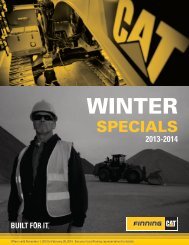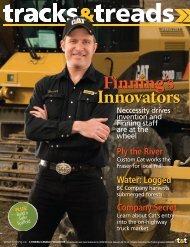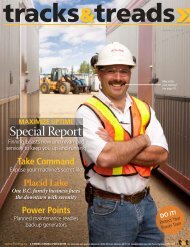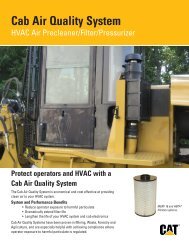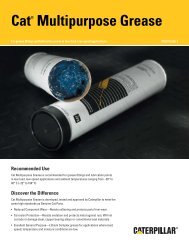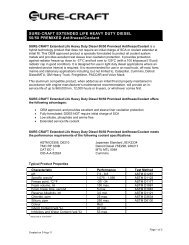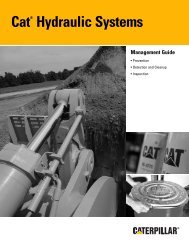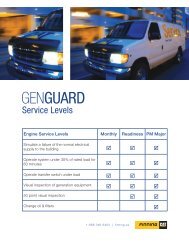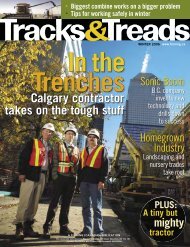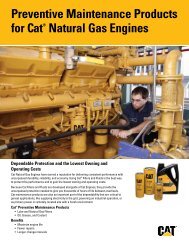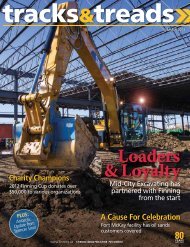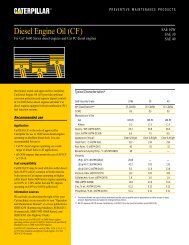On the Cover - Finning Canada
On the Cover - Finning Canada
On the Cover - Finning Canada
Create successful ePaper yourself
Turn your PDF publications into a flip-book with our unique Google optimized e-Paper software.
'Tis <strong>the</strong> SeasonBY HILARY ANAKA,FINNING EDITORCelebrate safely and reach out to o<strong>the</strong>r peoplewho are not as fortunateHow can you tell <strong>the</strong> holiday season is upon us?The influx of party invitations, <strong>the</strong> wish lists from<strong>the</strong> children in our lives, <strong>the</strong> carols taking over <strong>the</strong>radio waves and <strong>the</strong> long lineups in <strong>the</strong> malls – <strong>the</strong>seare all pretty good indicators that <strong>the</strong> special time ofyear is here.Amidst <strong>the</strong> pressure of finishing things up at workbefore <strong>the</strong> holidays and <strong>the</strong> stresses of <strong>the</strong> season inour personal lives, we can quickly lose sight of twoof <strong>the</strong> most important thingsWe can all give back, whe<strong>the</strong>rwe approach giving alone,as a family, or with a groupof coworkers.this time of year – safety andgiving back.Whe<strong>the</strong>r it’s <strong>the</strong> dauntingtask of putting up Christmaslights after <strong>the</strong> snow flies or <strong>the</strong>amount of driving we’re doingin poor wea<strong>the</strong>r conditions and low light, <strong>the</strong> riskof injury is greater at this time of year. As we’re distractedby <strong>the</strong> to-do list, <strong>the</strong> busy schedule that needsto be juggled and <strong>the</strong> pressure to make <strong>the</strong> most of itall, we open ourselves and our loved ones to danger.Take <strong>the</strong> time to consider <strong>the</strong> risks in your holidayroutine and do your best to remove <strong>the</strong>m so you andyours can enjoy your time toge<strong>the</strong>r.With a dose of perspective, <strong>the</strong>se typical holidaystresses we’re experiencing pale in comparison to <strong>the</strong>experiences of people less fortunate than us. Somedon’t have a roof over <strong>the</strong>ir heads, food to put on <strong>the</strong>table or a gift to give <strong>the</strong>ir children. They need ourgenerosity now more than ever. We can all give back,whe<strong>the</strong>r we approach giving alone, as a family, orwith a group of coworkers.The <strong>Finning</strong> family is getting out in <strong>the</strong> communitieswhere we live and work and we are “paying itforward.” Our executive team is leading by exampleand supporting an Edmonton school's underprivilegedstudents, while o<strong>the</strong>r groups are undertakingfood and clothing drives, contributing to Christmashampers and wrapping toys for charity. These simpleacts capture <strong>the</strong> essence of <strong>the</strong> season and mean somuch to people on <strong>the</strong> receiving end of kindness.<strong>On</strong> behalf of <strong>the</strong> <strong>Finning</strong> family, best wishes to youand yours this season. Please celebrate safely.4 Winter 2012www.finning.ca
WINTER 2012 Volume 53, No. 4PUBLISHERRuth Kellyrkelly@venturepublishing.caFINNING EDITORHilary Anakahanaka@finning.caASSOCIATE PUBLISHERJoyce Byrnejbyrne@venturepublishing.caEDITORMifi Purvismpurvis@venturepublishing.caEDITORIAL ADVISORSJeff Howard,Michelle LoewenART DIRECTORCharles Burkecburke@venturepublishing.caASSOCIATE ART DIRECTORAndrea deBoerASSISTANT ART DIRECTORColin SpencePRODUCTION COORDINATORBetty-Lou SmithPRODUCTION TECHNICIANBrent FelzienCIRCULATION COORDINATORJennifer Kingcirculation@venturepublishing.caLOST AND FOUND: In 2013, as <strong>Finning</strong> enters its 80th year in business,we have been doing some reminiscing. And <strong>the</strong>re is nothingquite like a walk down memory lane. We love getting your old<strong>Finning</strong> and Caterpillar images in <strong>the</strong> post and by email. So if, ina fit of winter cleaning, you open <strong>the</strong> shoe boxes inhabiting yourbasement and closets to find something that counts as <strong>Finning</strong> orCat memorabilia and you want to share it, please contact us at <strong>the</strong>address below. Items may include pictures, pins, badges, documentsor o<strong>the</strong>r tributes to days gone by. If we publish a photo of yourmemorabilia, we’ll send you some cool Cat swag.ADVERTISING REPRESENTATIVEAnita McGillisamcgillis@venturepublishing.caCONTRIBUTING WRITERSRobin Brunet, Caitlin Crawshaw, Craille Maguire Gillies,Keith Haddock, Cailynn Klingbeil, Lindsey Norris,Tricia Radison, Lisa RicciottiCONTRIBUTING PHOTOGRAPHERS AND ILLUSTRATORSStuart McCall, Shawn Talbot, Chip Zdarski, Colleen ZwarichTracks & Treads is published to provide its readerswith relevant business, technology, productand service information in a livelyand engaging manner.Tracks & Treads is published for<strong>Finning</strong> <strong>Canada</strong> byVenture Publishing Inc.10259-105 StreetEdmonton, Alberta T5J 1E3Phone: 780-990-0839Fax: 780-425-4921Contents © 2012 by <strong>Finning</strong> <strong>Canada</strong>. No part of this publicationshould be reproduced without written permission.PM #40020055Tell us what you thinkTracks & Treads would love to hear from you. Tell us what you thinkof <strong>the</strong> magazine’s stories, columns and look, so that we can improveit and make it a more interesting read.Send your comments to editor-in-chief Hilary Anaka by email athanaka@finning.ca or <strong>the</strong> old-fashioned way to: Hilary Anaka, Tracks & Treads,<strong>Finning</strong> <strong>Canada</strong>, 16830 – 107 Avenue, Edmonton, Alberta T5P 4C3www.fi nning.cawww.finning.ca Winter 2012 5
The Name GameAll Mini Machine Services, an earthworksrental equipment and excavating company basedin Delta, B.C., was <strong>the</strong> winning company for thissummer’s Name on NASCAR contest. Weeks afterhis all-expenses paid, week-long trip to Charlotte,North Carolina, Steve Borden, All Mini’s CEO, wasstill buzzing with excitement. “This was way over<strong>the</strong> top,” Borden says, adding how he met <strong>the</strong> pitcrew and drivers and had <strong>the</strong> opportunity to hangout in <strong>the</strong> Cat suite, an upscale lounge for VIPs.The contest started with companies that ownedyellow iron entering two categories: fleet of 25and over or fleet under 25. With nine pieces, AllMini entered <strong>the</strong> latter category, uploading <strong>the</strong>company’s name, <strong>the</strong> total pieces of Cat Equipmentit owned at <strong>the</strong> time, a short description of All Miniand a picture to winat<strong>the</strong>workshop.com/race.When entries closed on August 3, 2012, <strong>the</strong>e-mail voting began. <strong>On</strong>ly one vote was allowedper e-mail address per day from August 3 throughAugust 17.Borden says <strong>the</strong>y went to work, accessing <strong>the</strong>ir networks, begging friendsand family to vote online. By <strong>the</strong> time voting closed Friday, August 17, at 5p.m., All Mini had garnered almost 7,000 votes out of 16,000 in <strong>the</strong> under-25-pieces category. Borden and five employees were <strong>the</strong> lucky recipients of<strong>the</strong> prize to watch Nascar on October 13 and see <strong>the</strong> company’s name andlogo emblazoned on Caterpillar’s No.31 Sprint Cup car. It’s <strong>the</strong> first timethat NASCAR allowed a sponsor to put a customer’s logo on <strong>the</strong> side of acompeting car.“I’ve gotten a lot of exposure from it,” says Borden, a long-standingCaterpillar fan.Ekati to <strong>the</strong> (Mine) RescueBHP Billiton’s Ekati emergency responseteams earned high honours recently – first classat <strong>the</strong> 55th yearly Mine Rescue Competitionin Yellowknife, NWT. In June, 2012, Ekati sentboth surface and underground teams to <strong>the</strong>competition, hosted by The Workers' Safety andCompensation Board, which challenges nor<strong>the</strong>rnmines to enter.Ekati had a great showing. The NWT & NunavutChamber of Mines reports that <strong>the</strong> mine’s teamswon in <strong>the</strong> following categories: Overall Surface,First Aid, Surface Written Test, Surface Smokeand Surface Obstacle/Extrication. The Ekati teamincluded Peter Devolder (captain), vice-captainGlynn Normore, Darryl Klochko, Ryan Erickson,Donald Hebden, Gordon Frowen and NavidTaherdin.In September, <strong>the</strong> diamond mine, locatedmore than 300 kilometres north of Yellowknife,also sent a team to Donetsk, Ukraine for <strong>the</strong> 8thInternational Mine Rescue Competition. A greatexperience, <strong>the</strong> team met and learned from morethan 20 emergency response teams from around<strong>the</strong> world.More at EkatiEkati has welcomed its first 3900D. The mine recently purchased a3900D HaulMAX truck – <strong>the</strong> first of its kind in <strong>Canada</strong>. The truck is currentlyhauling kimberlite, <strong>the</strong> host ore for <strong>the</strong> mine’s legendary diamonds, fromEkati’s Misery pit to <strong>the</strong> ore processing facility on site.The owners and operators of <strong>the</strong> new truck, which is manufactured inTasmania, Australia, will evaluate it for safety, travel cycle times, payloadcapacity, maintenance performance and driver fatigue warning systems.Stay tuned for more!6 Winter 2012 www.finning.ca
Devastated by FireTwo-WheelersDevastated by FireWorkManagementTrioHaving trouble making <strong>the</strong> most of yourtime at <strong>the</strong> office? The fact is, you want tospend less time with your computer andmore time on site and with your customers.Now you can app your way to better officeproductivity with <strong>the</strong>se tech tools.RescueTimeMac or PC, Free or $6/monthEver wonder where your dayhas gone? RescueTime tracks<strong>the</strong> amount of time you spenddoing productive things (likeresponding to e-mails from clientsor writing reports) and how much time youwaste (Facebook and puppy videos). With apremium account, you can also set goals andhave RescueTime block distracting websites tokeep you on task. www.rescuetime.comSimple, well-executed plans offer <strong>the</strong> best results … and <strong>the</strong> mostfun, in <strong>the</strong> case of residents in <strong>the</strong> Town of Devon (a.k.a. Bike Town Alberta).Students in <strong>the</strong> Mountain Bike Club at Riverview Middle Schoolproposed to town council, more than a year ago, to build a mountain bikeskills park in <strong>the</strong> Voyager Park. Their proposal was accepted and <strong>the</strong> towncouncil awarded $45,000 to <strong>the</strong> team to kick off <strong>the</strong> project. The councilalso issued a challenge to <strong>the</strong> young people to go fur<strong>the</strong>r and raise moreto support <strong>the</strong> initiative. The middle schoolers did, and won $25,000towards <strong>the</strong> park project through a contest Kraft and TSN hosted. <strong>Finning</strong>caught word of this youth-led initiative and decided it was a perfectopportunity to help a thriving and hard-working community.Roy Cooper, general construction rep for <strong>Finning</strong>, thought it would begreat to donate <strong>the</strong> use and time of <strong>the</strong> iron for <strong>the</strong> cause.“I went to our different departments to secure <strong>the</strong> machines,” Coopersays. “Then I went to my customers and said, ‘Hey, this is what it’s about,can you help?’” Plenty of Cat iron was involved, including a backhoe and924K wheel loader, and loaner equipment transported directly to Devonby <strong>Finning</strong> customers Direct Transport Services and Big Al’s Transport.<strong>Finning</strong> played a huge part in <strong>the</strong> bike park’s completion and officialopening date of September 8, 2012 where it was christened RiverviewBike Park. The Town of Devon showed thanks by polishing up a Cat skidsteer and backhoe and parking <strong>the</strong>m beside <strong>the</strong> brand-new bike park forpicture opportunities.OmniFocusMac, $39.99; iPhone or iPad, $19.99You have a million things on<strong>the</strong> go and your to-do list won’tcut it. OmniFocus, inspired byproductivity guru David Allen’sbook Getting Things Done, is a taskmanagement app that puts o<strong>the</strong>rs toshame. Keep track of your projects, includingwho you need to call and where you need tobe, with OmniFocus’s easy-to-use features.www.omnigroup.com/omnifocusGoogle DriveMac, PC, iPhone and Android, FreeGoogle Docs is dead, long liveGoogle Drive. In April, Google saidgoodbye to <strong>the</strong>ir online Docs app,rolling it into <strong>the</strong> digital officesoftware suite/storage solution,Google Drive. Somewhere betweenMicrosoft Office and DropBox,Google Drive lets you read and editdocuments, spreadsheets and presentations,and access <strong>the</strong>m from any computer or yourmobile device. It comes with 5GB of freestorage. drive.google.comwww.finning.caWinter 20127
Stuck for Gifts?Look to <strong>the</strong> Heavy Duty Gear Store for<strong>the</strong> tough-to-buy-for yellow iron lover onyour list, whe<strong>the</strong>r it's a he, she or just wee.Nothing naughty, only nice.CT660 Fleece Caterpillar BlanketYou haven’t seen it all until you’ve seen this cosyfleece blanket, emblazoned with a picture of <strong>the</strong>new Cat CT660 on-highway truck. Measuring 60"wide by 45" tall, it will warm your engine.Price: $19.99Worker BearSay hello to <strong>the</strong> cuddliest and hardestworking teddy you’ll ever meet. With ahandsome plastic Cat hardhat and a soft-toytool belt, he is ready to work.Price: $23.99Caterpillar Construction ExpressA toy appropriate for a kid over five, this trainwould also look great on <strong>the</strong> Cat aficionado’sbookshelf or desk, too. The set includes14 feet of track, working headlights, andthree Caterpillar construction machines. Acollector’s item, quantities are limited.Price: $49.99No. 31 Action Platinum Series 1:24 ScaleModelJust like <strong>the</strong> real thing, this collector’s model from<strong>the</strong> NASCAR Sprint Cup Series is a mini replica ofNo. 31 Cat Global Mining Chevrolet that clincheddriver Jeff Burton a top-10 place on <strong>the</strong> half-mileoval. A die-cast of <strong>the</strong> one-time-only paint scheme,it’s Burton's No. 31 Chevrolet down to every lastdetail.Price: $89.99For more great gift ideas, head to heavydutygear.caStocking StuffersIf Santa needs a littlehelp filling stockingsthis year, check out<strong>the</strong>se fun Cat items.A Cat yellow ceramicmug for $11.99,a kids big truckt-shirt for $11.99,Cat safety-<strong>the</strong>medplaying cards for$5.99, or a Cat blackand gold sierra knifefor $19.99.8 Winter 2012 www.finning.ca
Walk a Mile in Her ShoesIn <strong>the</strong> fall, <strong>Finning</strong> president Andy Fraser fearlesslyled 25 men from <strong>Finning</strong>, all of whom donned heels to raisemoney for a YWCA event called Walk a Mile in Her Shoes.<strong>On</strong> September 11, <strong>the</strong> guys turned up at Churchill Squarein downtown Edmonton to <strong>the</strong> surprise and entertainmentof passersby. Aside from rocking <strong>the</strong> look, <strong>the</strong>ir effortssupported <strong>the</strong> YWCA’s family violence recovery andprevention programs.“We set a team goal to raise $25,000, and thanks to <strong>the</strong>efforts of our employees and <strong>the</strong> generous support of ourdonors we surpassed it,” Fraser said at <strong>the</strong> event.<strong>On</strong>-highway truck manager Harold Denenfeld receivedan award for most money raised by an individual and <strong>the</strong><strong>Finning</strong> team won for most money raised by a group.“Mention <strong>the</strong> name ‘<strong>Finning</strong>’ and one immediatelythinks of a tough industry. These men were willing to stepoutside that image, have some fun and raise awareness andmoney that will directly benefit women and children in ourcommunity,” YWCA CEO Jackie Foord told <strong>Finning</strong>. “Theycertainly led <strong>the</strong> way and perhaps we’ll see o<strong>the</strong>rs in <strong>the</strong>industry join <strong>the</strong>m next year.”Nothing like throwing <strong>the</strong> gauntlet down.New Truck at WorkSome of <strong>the</strong> first CT660 trucks from Caterpillarare at work in sunny Alberta. The CT660, a classeightvocational truck, was unveiled by Caterpillarin 2011. The initial units are rolling off <strong>the</strong> lot andone of <strong>the</strong> first CT660 customers, Highway RockProducts, is hauling 35 tonne loads of gravel forland development in major road works projects inAlberta.Highway Rock Products is hauling with threetrucks complete with dump bodies and quad wagongravel trailers, all relying on <strong>the</strong> Caterpillar automatictransmission for flawless power delivery. The CT660has many, many application possibilities: <strong>the</strong>re arethousands of ways to configure <strong>the</strong> chassis.“The primary feature customers like about <strong>the</strong>truck is <strong>the</strong> Caterpillar automatic transmission,” says<strong>Finning</strong>’s Richard Crookes, major account managerfor on-highway products at <strong>the</strong> Edmonton truckfacility. “But everyone really likes <strong>the</strong> cab featuresand <strong>the</strong> operator environment.”For <strong>the</strong> most part, customization is done closeto <strong>the</strong> delivery region. The CT660 is available for sale in three locations, Calgary,Edmonton and Surrey. Each area has access to customization suppliers familiarwith <strong>the</strong>ir local market. CT660 models are on <strong>the</strong> sales lot at all three spots.Currently, <strong>Finning</strong> is about 14 weeks from order to handing you a key so you candrive off <strong>the</strong> lot.www.finning.caWinter 20129
BY JEN JANZEN, CAILYNN KLINGBEIL AND MIFI PURVISBy <strong>the</strong> Numbers2,000Distance in miles of “The Coldest Journey”,a winter traverse of <strong>the</strong> Antarctic led by SirRanulph Fiennes and Peace River-raised heavyduty mechanic Spencer Smirl, who has workedfor <strong>Finning</strong> since 2003Number ofcustomized CatD6N tractors thatwill tow speciallyengineeredcabooses across2<strong>the</strong> Antarctic5Number offrost-bittenfingerstipsSir Ranulph removedfrom his left handwith a power sawin his backgarden1,000Length in miles of <strong>the</strong> February’s Yukon QuestInternational Sled Dog Race betweenWhitehorse and Fairbanks, Alaska£10 millionAmount “The Coldest Journey” will raise forSeeing is Believing, an international charitythat works to eliminate avoidable blindnessand visual impairment across <strong>the</strong> world15,000Number of people who attend <strong>the</strong> annualNumber of people who attend <strong>the</strong> annualHokitika Wildfoods Festival in New Zealand, whichfeatures fritters and ice cream laced with huhugrubs, punga fern, worms and sheep’s testicles2.52.5Length,ininches, of <strong>the</strong>almond-tastinghuhu grubswhen fullgrownYears <strong>the</strong> FrostbiteMusic Festival has beenheld in Whitehorse in33February1Rank of Whitehorse amongCanadian cities in terms of dryness-51.2Record low in Celsius forWhitehorse in February10 Winter 2012 www.finning.ca
BY KEITH HADDOCKWherever There's MiningCaterpillar’s new line of draglines boasts a richheritage of three prominent manufacturersWALKER: As <strong>the</strong> world’s first walking dragline, this Monighan 1-Tof 1913 swung a one-yard bucket. Bucyrus acquired <strong>the</strong> Monighancompany in 1934 and added walking draglines to its product line.NICKNAME: “Big Muskie”, <strong>the</strong> world’s largest dragline at 14,500tons, dwarfs a pair of Caterpillar D9 bulldozers at an Ohio surfacecoal mine. The bucket holds 220 cubic yards of overburden, <strong>the</strong>biggest ever suspended on a boom.Caterpillar’s recent purchase of BucyrusInternational Inc. places <strong>the</strong> company in an enviableposition to supply and service all types of <strong>the</strong> world’smining equipment. Highly-specialized Bucyruswalking draglines include some of <strong>the</strong> largest mobileequipment ever to move on <strong>the</strong> planet.The first dragline was <strong>the</strong> brainchild of Chicagoexcavation contractor, John W. Page, who needed amachine to dig below its own level and cast <strong>the</strong>material well clear of <strong>the</strong> excavation. In 1904, heconstructed a wooden-boom derrick to operate abucket suspended by ropes. The bucket dug when <strong>the</strong>operator pulled it toward <strong>the</strong> machine, and dumpedwhen he hoisted and swung to <strong>the</strong> desired location.Following its success, Page started building <strong>the</strong> newtype of excavator for saleto o<strong>the</strong>rs. He arrangedwith Monighan MachineWorks of Chicago tosupply <strong>the</strong> machinery,while Page supplied hispatented bucket andstructural steel parts.Monighan became amajor force in walkingdragline manufactureand years later, in 1934,<strong>the</strong> company would bepurchased by Bucyrus.Bucyrus entered <strong>the</strong>dragline business in 1910by purchasing <strong>the</strong>manufacturing rights of<strong>the</strong> Heyworth-NewmanDragline Excavator fromdrainage contractor,James O. Heyworth, whobuilt and employed hisown machines in <strong>the</strong>Chicago area. The nextyear, Bucyrus introduced<strong>the</strong> Class 24 as <strong>the</strong>world’s largest draglinecarrying a 3 1/2-cubicyard bucket on a 100-foot boom. A full rangeof similar modelsfollowed including, in1912, a Class 14, <strong>the</strong> firstBucyrus excavator to be equipped with crawler tracks.The last existing Class 24 stands fully restored at <strong>the</strong>Reynolds Alberta Museum, Wetaskiwin, Alberta.These early Bucyrus draglines were of <strong>the</strong> nonwalkingtype, mounted on skids and rollers, crawlers,or on rails. They did <strong>the</strong> job <strong>the</strong>y were intended to do,and hundreds were sold up to <strong>the</strong> 1930s. But <strong>the</strong>irlimited mobility was an obvious restriction. A vastlyimproved system of moving bulky draglines wasinvented in 1913 by Oscar Martinson, chief engineerat Monighan. The ingenious device employed a pair oflarge shoes, one on each side of <strong>the</strong> machine, movingin unison to raise and propel <strong>the</strong> machine in a walkingmotion. Knowing a good idea when <strong>the</strong>y saw one,Bucyrus management gained full control of Monighanin 1934, and walking draglines became one of <strong>the</strong>irkey products. Many early Monighan design featuresare still apparent in <strong>the</strong> walking draglines of today.In <strong>the</strong> 1960s, <strong>the</strong> era of giant surface miningmachines, Bucyrus and its main competitor MarionPower Shovel built machines of a size that no o<strong>the</strong>rcompany has yet exceeded. Most famous of all was aBucyrus walking dragline weighing some 14,500 tonsand known as “Big Muskie.” It swung a whopping 220-cubic-yard bucket on a 310-foot boom, and went towork in 1969 as one of <strong>the</strong> largest mobile earthmovingmachines <strong>the</strong> world has seen.Bucyrus fur<strong>the</strong>r increased its market share byeventually purchasing two of only three competitorsin <strong>the</strong> walking dragline industry. In 1988, it purchasedBritish company Ransomes & Rapier Ltd. who, in <strong>the</strong>1960s, had built some of world’s largest walkingdraglines and had pioneered lightweight booms withtubular gas-filled structural members. In 1997, after113 years of rivalry, Bucyrus purchased <strong>the</strong> MarionPower Shovel Company. Marion was established in1884 as <strong>the</strong> Marion Steam Shovel & Dredge Companyand grew into one of <strong>the</strong> foremost manufacturers ofshovels, walking draglines and drills.Through <strong>the</strong>se and o<strong>the</strong>r strategic acquisitions over <strong>the</strong>years, Bucyrus was not only able to employ <strong>the</strong> best designfeatures from <strong>the</strong>se companies’ designs, but also placeitself in a position to support 90 per cent of <strong>the</strong> westernworld’s walking dragline population. The combinedheritage of three long-standing companies in <strong>the</strong> walkingdragline field, Bucyrus, Marion and Rapier, is now part ofCaterpillar Global Mining, elevating <strong>the</strong> company to <strong>the</strong>enviable position of serving <strong>the</strong> world’s existing draglinefleets and also marketing new machines.www.finning.ca Winter 2012 11
TipsOPERATORSThe Middle GroundIn <strong>the</strong> quest for accuracy, AccuGrade delivers,but won’t break <strong>the</strong> bankBY LISA RICCIOTTI“Everyone wants to dance with <strong>the</strong> mostattractive people,” says Ed Picher, a technology sales andservice representative with SITECH Western <strong>Canada</strong>.And in <strong>the</strong> world of earthmoving machines, everyonewants to take a fancy control system with GPS for aspin. But are <strong>the</strong>y forgetting <strong>the</strong> wallflowers?“The demand is just crazy for GPS,” Picher says. Andhe should know. By adding a high-tech system to <strong>the</strong>irmachines, operators can accurately grade or excavate asite and stay within centimetres of site specs – without<strong>the</strong> use of traditional stakes or a grade-checker. The siteplan, including design surfaces, grades and alignments,shows up as a 3-D image on a screen inside <strong>the</strong> cab, givingoperators fast, easy-to-understand feedback.Picher is happy that operators have embraced <strong>the</strong>high-tech benefits of GPS, but he worries about anunintended consequence of its popularity. While GPSis attracting all <strong>the</strong> attention with its flashy 3-D screens,<strong>the</strong> conventional 2-D laser-based reference systems arebeing forgotten. “Last year I sold about 40 GPS unitsand only two laser systems,” says Picher. And that’s ashame, because <strong>the</strong> laser systems work great – for alower sticker price.A 3-D GPS system typically runs $50,000 to $60,000.A conventional 2-D laser-based system, such asSITECH’s AccuGrade Laser Reference System, is availablefor $10,000 to $20,000. Like GPS, lasers increaseoperator productivity and work quality, and eliminate<strong>the</strong> need to assign staff to grade-stick duty. Caterpillarestimates that using an AccuGrade System can increase<strong>the</strong> accuracy and productivity by as much as 50 per centover traditional methods.“It’s all about maximizing efficiencies and loweringoperating costs while getting it right <strong>the</strong> first time,”Picher says. The laser system has a range of applicationsfor construction earthwork projects that require tighttolerances and high production, ranging from roads toairport runways, landfills, building pads and agricultureterraces. <strong>On</strong>e caveat if you’re considering an upgrade:laser works best on relatively flat terrains or those witha consistent slope. For operators in hilly locales withunpredictable dips and rises, GPS is <strong>the</strong> better choice.Daryl Michell, president of Michell Excavating,discovered that adding an AccuGrade laser system toone of his Cat machines has put his business on a morelevel playing field – literally. The family-run business hasoperated successfully for 50 years, but as Michell found more of his recent projectscame with very precise grading requirements, he decided it was time to increase hisoperators’ accuracy.“We were using <strong>the</strong> man-and-a-stick method,” says Michell. “That means a lot oftime running around. When we got municipal contracts to create new soccer andbaseball fields in Nanaimo and Victoria, we felt it was time for a different approach.Both fields required very precise work, and with <strong>the</strong> laser system, we can grade withina quarter-inch of a plan.”Making <strong>the</strong> switch from manual to machine control was a smooth and easyprocess. “It only took our operators a few hours to get <strong>the</strong> hang of it and <strong>the</strong>y reallylike it,” Michell says. <strong>On</strong>e of <strong>the</strong> biggest fans of <strong>the</strong> new laser system is his son. Next,Michell will put his new AccuGrade laser system to work constructing a BMX trackin Red Deer.“Let’s not forget <strong>the</strong>re’s ano<strong>the</strong>r option between going all-out GPS and <strong>the</strong> oldschoolstakes-and-grade-checker approach,” says Picher. “A laser-based referencesystem is a great solution.”So even if you can’t afford <strong>the</strong> most high-tech, prettiest GPS systems on <strong>the</strong> market,don’t overlook <strong>the</strong> less flashy laser option. It’s not 3-D, but it still offers high performancein an affordable package. And it could mean <strong>the</strong> difference between keeping yourbusiness’s dance card full and sitting on <strong>the</strong> sidelines watching high-accuracy projectsgo to competitors with upgraded equipment.HOW DOES ACCUGRADE WORK?Using advanced laser technology, machine-mounted components and an off-board lasertransmitter, AccuGrade Laser Reference System provides precise elevation information on anin-cab (2-D) display to achieve accurate blade position. As a result, operators can improveeffi ciency and get to grade faster and in few passes.12 Winter 2012www.finning.ca
MANAGERSBuildEngagementKeep workers on your shopfloor safe, content andproductive with hands-onmanagement strategiesBY CAITLIN CRAWSHAWIt’s a fact often repeated in managementliterature: most employees leave <strong>the</strong>ir jobs because of<strong>the</strong>ir managers.This won’t be welcome news for new managers hopingto build engagement on <strong>the</strong> shop floor. After all,whe<strong>the</strong>r you’ve been promoted from within, or werehired from ano<strong>the</strong>r company, it’s not easy buildingrapport with employees you’re managing. And, in anindustrial environment, you’ve got challenges that <strong>the</strong>managers in white-collar environments don’t.“In a manufacturing environment, you have lesstime to interact with employees. Workers might bedown in a mine or working with loud equipment,” saysAdam Reeve, human resources director at CanadianHR consulting firm Ceridian. “This just means <strong>the</strong> time<strong>the</strong>y have is more valuable and <strong>the</strong>y need to make <strong>the</strong>most of it.”Managers in blue-collar work environments also dealwith safety issues that <strong>the</strong>ir office-dwelling colleaguesdon’t. After all, workers may spend <strong>the</strong>ir days usingdangerous equipment, volatile chemicals, or machinesthat pose risks to <strong>the</strong>ir safety.But, while <strong>the</strong> stakes are high and <strong>the</strong> challenges arevery real, a new manager can successfully build engagement– with <strong>the</strong> right strategies.Reeve argues that managers should do all <strong>the</strong>y can tominimize distractions. Often, new managers bog downin administrative duties, reducing <strong>the</strong> time <strong>the</strong>y have tomanage people. But software solutions by companieslike Ceridian can allow employees to trade shifts or requestvacation days, freeing up <strong>the</strong> manager’s time. “It’slike online banking – but for your work,” he says.Kevin Burns, a Calgary-based workplaceexpert, agrees that <strong>the</strong> real job of a manager isn’tadministrative. “I’m a big believer that management ispeople work – not paperwork,” he says. To that end,he encourages new managers to spend as much time as possible on <strong>the</strong> shop floor.While you don’t want to distract workers, it is important to get to know <strong>the</strong>m. “It’sknowing more than <strong>the</strong> job function – it’s knowing <strong>the</strong> person,” he says.A manager’s attitude is also critical to building engagement. Burns argues thatnew managers need to ditch <strong>the</strong> m-word: motivation. “Can I motivate you to doanything? Not really. But, I can inspire you to do something,” he says. “I think <strong>the</strong>biggest challenge for new managers is believing <strong>the</strong>y have to motivate <strong>the</strong>ir people.”Instead, he urges <strong>the</strong>m to ask workers how <strong>the</strong>y want to be managed. Ask how oftenan employee wants to meet with a manager, how much feedback <strong>the</strong>y’d like, andwhe<strong>the</strong>r <strong>the</strong>y prefer speaking on <strong>the</strong> shop floor or away from peers. Doing so demonstratesyou trust and respect your team, and is likely to pay off big, says Burns: “Ifyou manage me <strong>the</strong> way I asked you to, why would I want to go anywhere else?”It can be difficult for new managers to resist <strong>the</strong> urge to assert <strong>the</strong>ir authority.However, a manager’s first job isn’t to police workers, but to enable <strong>the</strong>m to do <strong>the</strong>irjobs. “As a manager, you work for <strong>the</strong>m,” says Burns. Part of engaging staff meanscreating a safety culture that protects – and involves – workers. Staff need to be empoweredto identify where safety protocols could be improved and to help enforcethose rules. “It’s got to be bottom-up, grassroots, managers and front-line workingtoge<strong>the</strong>r,” he says.Workers are far more likely to follow safety regulations <strong>the</strong>y helped design thanrules thrust upon <strong>the</strong>m, says Burns. This can also help reduce <strong>the</strong> “us versus <strong>the</strong>m”attitude that sometimes exists between front-line workers and management, saysBurns. “If you can build a safety strategy that everyone’s happy with, and gets you<strong>the</strong> results you’re looking for, it doesn’t matter who’s in <strong>the</strong> management chair.”TOP 5 TAKEAWAYS:1) Get to know <strong>the</strong> employees you’re managing. Understanding <strong>the</strong>ir career ambitions andpersonal lives is key to getting <strong>the</strong> most from <strong>the</strong>m.2) Create an inclusive safety culture that values <strong>the</strong> input of workers and <strong>the</strong>ir well-being.3) If you’re not familiar with your employees’ jobs, do some research to understand <strong>the</strong>ir careeropportunities and help <strong>the</strong>m advance.4) Don’t manage from your offi ce – spend time on <strong>the</strong> shop fl oor.5) Create systems to deal with administrative hassles to free up time for people, not paper.www.finning.ca Winter 2012 13
YESSIR: Sir Ranulf Fiennes has been called<strong>the</strong> greatest living explorer.KEEP IT GOING: Mechanic SpencerSmirl will keep <strong>the</strong> expedition moving.TOPS: The rack on <strong>the</strong> iron foldsout to make a moveable garage.14 Winter 2012www.finning.ca
COLDESTJourney<strong>Finning</strong> service is key to keeping iron running –even on a historic trip to AntarcticaBY CRAILLE MAGUIRE GILLIESIn January 2012 mechanic Spencer Smirl wentthrough <strong>the</strong> most challenging job interview of his life. At <strong>the</strong>time he worked at <strong>the</strong> Ekati diamond mine in <strong>the</strong> NorthwestTerritories – two weeks on, two weeks off. Then he heardabout an opportunity that would change his life.Smirl was one of five applicants who wanted to represent<strong>Finning</strong> on a winter crossing of Antarctica with British explorerSir Ranulph Fiennes. It would be a 14-month journey, eight of thosemonths in near darkness at temperatures that could drop as lowas-90˚C. There would be no chance of rescue for months and it waspossible <strong>the</strong>y would fail. Smirl was all in. But first he had to pass<strong>the</strong> test.Smirl travelled from <strong>Canada</strong> to <strong>the</strong> <strong>Finning</strong> plant in Cannock,England. Along with ano<strong>the</strong>r mechanic, he accompanied expeditionmembers 30 hours to Arjeplog, a former silver mining areain nor<strong>the</strong>rn Sweden, where ex-military men put him through twoweeks of rigorous physical and psychological tests. “They triedto make it as stressful as possible,” Smirl recalls. The goal was todetermine whe<strong>the</strong>r he was not only a top-notch mechanic, but alsohad <strong>the</strong> creativity, strength and stamina to make what by now hadcome to be known as The Coldest Journey.He got <strong>the</strong> job, but his hardest work was still to come.The Coldest Journey began decades ago when Fiennesfirst thought of crossing <strong>the</strong> continent in winter. It was <strong>the</strong>re, on<strong>the</strong> Ross Ice Shelf, that Captain Robert Falcon Scott died in 1912,after finding that Norway’s Roald Amundsen had beaten him to<strong>the</strong> pole. And it was <strong>the</strong>re that Sir Ernest Shackleton was headedwhen he died of a heart attack in 1922. Antarctica has become amythic place, almost twice as big as Australia, and covered almostcompletely in ice. No one had ever completed a winter crossingwhen it is blanketed in darkness. Fiennes’ expedition wanted to be<strong>the</strong> first, but <strong>the</strong> technology of <strong>the</strong> time didn’t match <strong>the</strong>ir ambitions.They bided <strong>the</strong>ir time.Sir Ran, as expedition members call him, had gone to extremesbefore. He completed <strong>the</strong> Northwest Passage in 1981 and was <strong>the</strong>oldest person to summit Mount Everest, at <strong>the</strong> age of 64. Someof his expeditions, such as travelling alone across <strong>the</strong> North Pole,have failed. Along <strong>the</strong> way he came to be known as <strong>the</strong> world’sgreatest living explorer. But he still hadn’t made that last remain-www.finning.ca Winter 2012 15
The Coldest Journeying polar challenge, and he knew if he didn’t someone else surely would.Then, four years ago, expedition partner Dr. Mike Stroud brought up <strong>the</strong> questionof Antarctica. There were rumours that a Norwegian party was planning anexpedition. The Norwegians had beaten Shackleton as first to reach <strong>the</strong> South Pole;Fiennes didn’t want <strong>the</strong>m to beat him in his bid for a winter crossing.There was one catch: without reliable transportation, <strong>the</strong> British Foreign andCommonwealth Office wouldn’t grant <strong>the</strong> expedition a permit. “Mike and I hadbeen using <strong>the</strong> machinery of our legs and nothing else, and we can haul 500pounds,” Fiennes told Tracks & Treads. “That’s what we’re good at doing. But <strong>the</strong>foreign office made it clear that no Brit would be given a permit to go <strong>the</strong>re inwinter.” No ships or airplanes can access <strong>the</strong> region all winter, meaning if <strong>the</strong> teamdidn’t succeed – a distinct possibility – <strong>the</strong>y would perish. “They wouldn't have letus go until we proved we could be self-sufficient for a year until <strong>the</strong> short summercame around,” says Fiennes.To get <strong>the</strong> permit, <strong>the</strong> expedition needed machinery that could provide shelterif <strong>the</strong>y were, well, snowed in. That’s where <strong>Finning</strong> came in. Fiennes quickly realizedthat <strong>the</strong> Caterpillar D6N was possibly <strong>the</strong> only vehicle that could do <strong>the</strong> job.Yet two tractors would cost more than a $1 million and need to be extensivelymodified to make this first-ever trans-Antarctic journey. It was an impossibleexpense for <strong>the</strong> volunteer-led expedition, which is expected to raise close to £10million for <strong>the</strong> British charity Seeing is Believing. Fiennes remembered that 40years earlier he’d worked with Bowmaker Plant, a company <strong>Finning</strong> took over in<strong>the</strong> early 1980s, so he contacted a rep in <strong>the</strong> U.K. to see if <strong>the</strong> company could help.The answer was yes, and <strong>Finning</strong> design engineer Andy Thomas was tasked tomake customizations to <strong>the</strong> D6Ns. It took two years but he modified <strong>the</strong> machinesto enable <strong>the</strong>m to take <strong>the</strong> six-person expedition all 4,000 kilometres.Spencer Smirl’s coldest journey began more recently. Smirl, who willturn 30 on <strong>the</strong> expedition, grew up in Peace River, B.C. “We didn’t have a wholebunch of money growing up, so <strong>the</strong> outside was a cheap and easy place to play,”he says. “It was a giant playground.” In summers he motor biked with his bro<strong>the</strong>r,learning a bit about mechanics in <strong>the</strong> process. He spent <strong>the</strong> long Peace River winterssnowboarding and skiing and came to prefer winter.In <strong>the</strong> summer of 2003, when Smirl was working at a highway truck dealership,he ran into a high-school friend who had apprenticed for <strong>Finning</strong> in Edmonton.The friend later told him about a first-year apprenticeship. Smirl applied, got <strong>the</strong>job, and eventually worked his way around nor<strong>the</strong>rn Alberta – sometimes drivingup to 500 kilometres a day to service equipment. During winter, temperaturescould drop as low as -50˚C, giving him an early apprenticeshipin maintaining equipment during extremetemperatures. He went on to join <strong>the</strong> <strong>Finning</strong> branch inCalgary, where he assembled large-haul mining trucks,before heading <strong>the</strong> Ekati mine, more than 300 kilometresnorth of Yellowknife, N.W.T.After that trip to Sweden in early 2012, Smirl spent 15 weeks in England preparingfor The Coldest Journey. He’s been subjected to -58˚C temperatures in a coldchamber, installed modifications and updates to <strong>the</strong> dozers, and squeezed in a bitof crevasse training. Amid <strong>the</strong> trans-Atlantic training and prep trips, Smirl seemslaid-back and prosaic about <strong>the</strong> journey. “Everyone who knows me well can tell it’skind of suited for me.”Chances are, if Smirl had been around when Fiennes first thought of <strong>the</strong> expeditionhe wouldn’t have volunteered. “You could have done this 25 years ago, but youwould have needed a crazy mechanic to go out with you,” he says. “I wouldn’t havedone it.” Advances and customizations, such as a large tent that will keep <strong>the</strong> dozerswarm in Antarctic temperatures will make his job easier.“<strong>Finning</strong> has gone above and beyond anything that <strong>the</strong> expedition asked of<strong>the</strong>m,” Smirl says.The expedition will depart from a base camp en route to McMurdo Sound,Captain Scott’s base a century ago. It will take six months in near total darknessto travel 4,000 kilometres. The fur<strong>the</strong>st anyone has ever gone across AntarcticaCHILLIN: Spencer Smirl (circled) takesa break with <strong>the</strong> team in Sweden.In nor<strong>the</strong>rn Sweden, ex-military men putSmirl through two weeks of rigorousphysical and psychological tests.in winter? A mere 96kilometres.Smirl’s job is to driveand maintain <strong>the</strong> dozers–ano<strong>the</strong>r mechanicwill drive <strong>the</strong> second – itwill take eight hours to cover roughly 35 kilometresper day. There’s time allowed for maintenance on<strong>the</strong> machines, which will tow more than 55 tonnesof equipment (including 155,000 litres of jet fuel),a caboose filled with scientific equipment to studywinter ice depths and provide climate data, and asecond caboose to house expedition members. (TheTelegraph, a newspaper in Britain, described <strong>the</strong> latteras <strong>the</strong> team’s “life support system.”)Smirl’s perfect Antarctica day will begin withstarting dozers, turning on heaters, attending a teammeeting and freeing equipment that's frozen to <strong>the</strong>ground. <strong>On</strong>ce <strong>the</strong> cabooses are hooked up, <strong>the</strong>y willgrab <strong>the</strong>ir lunches and drive non-stop all day. (Fiennesand expedition co-leader Anton Bowring will ski infront of <strong>the</strong> D6Ns, using radar to find crevasses.)16 Winter 2012www.finning.ca
SPENCER SMIRLTEAM U.K.: (Left to right) Brian Newham, Ian Prickett,Tristam Kaye and Sir Ranulph Fiennes.“The biggest thing is to be diligent at <strong>the</strong> end of <strong>the</strong> day,” Smirl says. “I’llhave to open all <strong>the</strong> panels and inspect that machine more than I’ve inspectedanything in my life.” Weight limits also affect how many parts and tools hecan bring. “Out <strong>the</strong>re we need to catch stuff early, <strong>the</strong> smallest little leaks, <strong>the</strong>weirdest little noises.” In addition to daily checks, he’ll carry out scheduledmaintenance every 250 hours, a task that involves spinning all <strong>the</strong> filters andinspecting <strong>the</strong>m for contamination. He’ll check clutch pressures and cycletimes. “Normally you’d wait for something to break, but out <strong>the</strong>re it’s my lifeon <strong>the</strong> line. Catching something early is <strong>the</strong> difference between failure andsuccess.”While Smirl is keeping <strong>the</strong> expedition on course, Bowring will organizemarine activities to contribute to polar research on climate change. Meanwhile,<strong>the</strong> rest of <strong>the</strong> team are offering <strong>the</strong>mselves up as guinea pigs to see how <strong>the</strong>irbodies adapt to <strong>the</strong> cold. At night, with <strong>the</strong> dozers under <strong>the</strong>ir custom “teacozies,” <strong>the</strong> team will write blog posts, upload scientific data and update <strong>the</strong>irjournals. (Smirl has kept a journal since he was selected for <strong>the</strong> expedition.)Then <strong>the</strong> next day Smirl and <strong>the</strong> team will get up and do it all over again.Every single day, for six months.The Coldest Journey expedition will wind up about 1,300 kilometres from<strong>the</strong> South Pole, in February 2014. Then <strong>the</strong> team will board a ship to make <strong>the</strong>two-month journey home. “I won’t mind <strong>the</strong> boat ride,” Smirl says, “but it willbe nice to get home.”INTO THE COLDThis won’t be <strong>the</strong> fi rst time Caterpillar track-type tractorshave journeyed to Antarctica (<strong>Finning</strong> UK supplies <strong>the</strong>British Antarctic Survey with D5Ns), but it might be <strong>the</strong>coldest call <strong>the</strong>y've had into service. <strong>Finning</strong> spent twoyears and thousands of hours customizing <strong>the</strong> 22-ton D6Nsthat will be used in The Coldest Journey.The tractors started <strong>the</strong>ir customization at a top-secretengineering workshop in rural England. There, lead engineerAndy Thomas designed a horseshoe-shaped crevassearm and crane. Thomas and his team created castellatededges on <strong>the</strong> tracks so it can grip <strong>the</strong> ice. The cabs wereinsulated and canopies were added to hold a custom<strong>the</strong>rmal tent to protect <strong>the</strong> mechanics. (During testing, twohours of idling raised <strong>the</strong> temperature inside <strong>the</strong> tent from-35˚C to 35˚C.)With temperatures expected to drop to -70˚C, <strong>the</strong> dozerswere modifi ed to protect drive belts and batteries, and tokeep aviation fuel from freezing. Key modifi cations includeadding Wabasto diesel heaters to keep <strong>the</strong> engine coolantat a pre-set temperature, heat exchangers for <strong>the</strong> fuel andhydraulic tanks, and a heating plate for <strong>the</strong> batteries.After customization and testing, <strong>Finning</strong> engineers werestill fi ddling with parts only weeks before <strong>the</strong> trip. Afterall, <strong>the</strong>y’re <strong>the</strong> linchpin in a mobile vehicle landtrain thatincludes two cabooses (one scientifi c, one shelter), spareparts and enough non-freezable fuel to survive <strong>the</strong> journey.www.finning.ca Winter 2012 17
WEEKEND WONDER: A part-time landscapinggig just wouldn't stop growing.18 Winter 2012www.finning.ca
Great Employee,Great CustomerMike Tupper credits his years at <strong>Finning</strong> andhis inside knowledge of <strong>the</strong> iron for aiding<strong>the</strong> phenomenal growth of his companyBY ROBIN BRUNET / PHOTOS BY STUART MCCALLSince <strong>the</strong> late 1990s, Mike Tupper has grownhis North Vancouver-based business, TupperLandscaping, from a weekend venture of layingpavestone walkways to providing full-turnkey residentialdemolition and servicing as well as commercial excavation.These days, he has a fleet of more than 30 machines,most of <strong>the</strong>m Caterpillar, plus a carefully selected staff of16 at his disposal.It’s a remarkable achievement at a time when o<strong>the</strong>r contractorsare still recovering from <strong>the</strong> economic downturnand hedging <strong>the</strong>ir bets about <strong>the</strong> future. But Tupper, 38,is easy-going about his success. “All I wanted to do waswork, and <strong>the</strong> business has flourished beyond my wildestexpectations,” he says. “I never envisioned I’d evolve fromlandscaping to commercial excavating, and in many waysI have <strong>Finning</strong> to thank.”Indeed, while many entrepreneurs rely on <strong>Finning</strong>for equipment, service and advice, Tupper’s experienceis far more intimate: he joined <strong>Finning</strong> at <strong>the</strong> age of 19,following in <strong>the</strong> footsteps of his fa<strong>the</strong>r, Robyn, who spent43 years at <strong>Finning</strong> as a heavy duty diesel mechanic. “Thetechnical know-how as well as <strong>the</strong> extensive safety trainingserved me extremely well,” he says.Tupper and his crew are currently busy with a host ofprojects, including excavation for several new high-risecommercial/residential facilities in downtown Vancouver,as well as turnkey work for multi-million dollar WestVancouver properties. Although he can handle <strong>the</strong> mostdemanding of projects, Tupper notes that it took “a decadeof hard work before I secured my first turnkey job fouryears ago, demolishing a building, excavating, pouring in<strong>the</strong> gravel, slab prep, and <strong>the</strong>n providing all <strong>the</strong> servicesafter <strong>the</strong> new building is erected. It took that long toestablish trust with <strong>the</strong> developers and prove to <strong>the</strong>m mycrew could operate under <strong>the</strong> strictest of safety standards.”<strong>Finning</strong> <strong>Canada</strong> sales manager Steve Cook, a longtimefriend and former colleague, notes that Tupper’sbackground makes for an interesting relationship. “Heknows <strong>the</strong> equipment market inside and out, plus he’squalified to perform preventive maintenance and he'sadept at training his operators,” he says. “All of this hasgiven him a distinct business advantage.” After a pausehe adds, “But for all of his expertise, it’s not uncommonfor him to phone me at night seeking a second opinion.”As a teenager, Tupper was attracted to <strong>Finning</strong>.“Dad would come home and tell me stories abouthis day, and I would occasionally visit him at <strong>the</strong> oldVancouver headquarters on Station Street,” he says.The idea of fixing heavy machinery that was used forlogging and mining struck Tupper as important andexciting. “Also, <strong>Finning</strong> was <strong>the</strong> place where Dad metmy Mom, Christine: she handled <strong>the</strong> paperwork necessaryfor Caterpillar machines to be transported across<strong>the</strong> border.”After graduating high school, Tupper began hiscareer in 1993, changing oil in <strong>the</strong> truck shop. Hemoved on to <strong>the</strong> Marine division, gained experiencein power generation, and even learned <strong>the</strong> intricaciesof shipping engines to remote locations.But on weekends, a casual pastime of cutting grassand pulling weeds to earn extra money was unexpectedlyand rapidly turning into serious business: “Beforelong I was laying pavestone walkways, <strong>the</strong>n clientswanted me to build retaining walls, and <strong>the</strong>n I neededto buy a mini excavator – and in 1998 <strong>the</strong> work was sovoluminous I decided to register as a company.”Tupper kept his day job and spent evenings coordinatinglandscaping projects with <strong>the</strong> help of two colleagues.“Good word of mouth made <strong>the</strong> business grow,but in 2002 it had grown to <strong>the</strong> point where I was forcedwww.finning.ca Winter 2012 19
Great Employee, Great CustomerDIGGING IT: Tupper's rep Steve Cook has suppliedmore than a dozen machines in 10 years.to make <strong>the</strong> hardest decision of my life and leave <strong>Finning</strong>,” he recalls. Tupper’s trepidationabout striking out on his own was compounded by <strong>the</strong> fact he had recentlypurchased a home.Work increased steadily, and Tupper soon linked up with Steve Cook, <strong>the</strong> outcomeof which was 13 Caterpillar purchases over <strong>the</strong> next decade. “Mike had a mini-excavatorand I worked with him to show him what was available through Cat,” Cook recalls.Of <strong>the</strong>se units, Tupper regards his 301.8, 304 and 305.5 mini excavators to be his keymachines, as well as a full-size 330 hydraulic excavator that he says “cost me a lot ofsleepless nights in terms of <strong>the</strong> money I was investing.” A variety of tandem dumptrucks and o<strong>the</strong>r machines completed Tupper’s inventory.With <strong>the</strong> right equipment and expertise, Tupper and his crew can handle up to15 projects at any given time (turnkey projects can easily last a year, given <strong>the</strong> natureof high-end residential construction), and although maintenance is provided by anin-house mobile mechanic, Tupper still relies on <strong>Finning</strong> for parts. “I’ve built arelationship of mutual trust with people like Steve, which is virtually impossible todo with competitors and yet is critical when equipment breaks down and parts arerequired immediately,” he says.Earlier this year, Tupper focused his attention on commercial excavating incollaboration with Power Shotcrete Shoring Ltd., and as a result he works six daysa week and spends <strong>the</strong> seventh “handling paperwork with my wife Brooke.”The routine is made somewhat easier now that <strong>the</strong> couple’s twin daughters, Avaand Sophie, are in kindergarten, but <strong>the</strong> long hours have prompted <strong>the</strong> easy-goingTupper to consider <strong>the</strong> future. “Time has flown, and <strong>the</strong> question is how much I cangrow Tupper Landscaping before I start losing control,” he says. “I don’t want that tohappen. I’m too hands-on – ano<strong>the</strong>r <strong>Finning</strong> legacy.”No matter what lies ahead, Tupper is grateful for his success. “If it weren’t for<strong>Finning</strong> I wouldn’t be here, and whe<strong>the</strong>r I perform maintenance on a truck or do asafety check at a jobsite, you can trace my expertise back to <strong>the</strong> wonderful trainingand mentorship I received from people who are <strong>the</strong> best in <strong>the</strong> business,” he says.“<strong>Finning</strong>’s influence on me will never go away.”BEST BET: When Mike Tupper hung up ashingle, he knew where to turn to for iron.20 Winter 2012www.finning.ca
BY CAILYNN KLINGBEILStick to ItA simple and effective safetyprocedure catches on with<strong>Finning</strong>'s customersWhen <strong>Finning</strong> field mechanic Sean Mowez first stuckmagnetic lockout tags on a machine he was testing for Canfor atits sawmill in Mackenzie, British Columbia, his coworkers wereconfused.“They had never seen <strong>the</strong>m used before so <strong>the</strong>y wanted toknow what <strong>the</strong> heck was going on,” Mowez says. “They said,‘What do you have <strong>the</strong>re on <strong>the</strong> side of your machine?’ ”Mowez explained <strong>the</strong> purpose of <strong>the</strong> live lockout tags, how<strong>the</strong> magnetic signs are put in a conspicuous location on <strong>the</strong>machine to alert o<strong>the</strong>rs that <strong>the</strong> machine is being tested and isnot available for general use.“For everybody at <strong>Finning</strong> it’s a very obvious thing. We all use<strong>the</strong> tags to show that <strong>the</strong> machine is locked up but it’s still live,”Mowez says. He notes <strong>the</strong>re are many safety issues present if heis repairing a big machine. At a glance, not everyone would realize he is working onit. “People could jump in and drive away,” he says.A crucial part of <strong>the</strong> sign is <strong>the</strong> magnetic backing, which allows it to easily bestuck to machines with no fastening required. “It’s a neat thing, <strong>the</strong>se live lockouttags, as you can stick <strong>the</strong>m pretty much anywhere on <strong>the</strong> machine,” Mowez says of<strong>the</strong> safety procedure. “They let people know <strong>the</strong> unit is being tested and live testingand adjusting is going on. It’s a very visible sign to o<strong>the</strong>rs.”Mowez has worked for <strong>Finning</strong> for seven years in various locations, and currentlyuses his truck as his office as he services various sites in Mackenzie and nor<strong>the</strong>rnBritish Columbia. He carries many tags with him and uses <strong>the</strong>m wherever he works.But while <strong>Finning</strong> employees are familiar with <strong>the</strong> tags and thier use as a simplebut important means of communication, Mowez said employees at <strong>the</strong> Canfor site inMackenzie weren't so familiar with <strong>the</strong>m. <strong>On</strong>ce Mowez had explained <strong>the</strong> procedure,however, Canfor staff liked <strong>the</strong> idea so much that <strong>the</strong>y soon adopted it as <strong>the</strong>ir own.“The guys in <strong>the</strong> shop really liked it and <strong>the</strong> foreman came up and asked me aboutit, and if he could borrow it,” Mowez says.Dan Szekely, mobile shop and log yard supervisor at Canfor, says <strong>the</strong> <strong>Finning</strong> taghas been worked into Canfor’s procedures.“We were in <strong>the</strong> process of updating our lockout procedures for our mobile equipment.We didn’t have anything really good for live lockouts,” Szekely says. “Sean ishere helping us out frequently with our Cat gear, and I figured if anyone has a goodupdated procedure for live lockout on mobile, it’s <strong>Finning</strong>. So I asked him his proceduresand he showed me <strong>the</strong> tags.”When Mowez showed Szekely <strong>the</strong> tags <strong>Finning</strong> uses, Szekely thought <strong>the</strong>y wouldbe perfect for Canfor’s purposes. Canfor soon commissioned some tags, with <strong>the</strong>company changing <strong>the</strong> <strong>Finning</strong> logo to Canfor’s, and <strong>the</strong>y have since worked <strong>the</strong> livetesting tagging system into its safety procedures.“It’s functional and efficient,” Szekely says. “Itdoesn’t take a lot of time, it just works. With o<strong>the</strong>rtags you’re fastening <strong>the</strong>m on, with this one you’reslapping it to <strong>the</strong> machine. It’s so simple and whenyou’re done you just peel it off. It’s working quite wellfor us.”Mowez believes that every <strong>Finning</strong> employeeshould be using <strong>the</strong> tags no matter what site <strong>the</strong>y areworking at. “It’s been great,” he says of <strong>the</strong> project’suptake. He’s happy he’s been able to share <strong>the</strong> simplebut important safety procedure with a new site.TOP 4 BENEFITS<strong>Finning</strong>’s live lockout tags are proving <strong>the</strong>mselvesvaluable for staff and now customers, too. Here’show <strong>the</strong>y’re working:CLEAR AS A BELL The uniform signs serve as a clearmeans of communication to o<strong>the</strong>rs that <strong>the</strong> machineis live and that a tech is working on it.MAGNETIC EASE Techs can slap <strong>the</strong> magnetic signseasily onto numerous spots on any machine.SIMPLICITY While o<strong>the</strong>r tagging systems requirefastening, <strong>the</strong> magnetic design is efficient and simpleto apply to a machine.PORTABLE, TOO <strong>Finning</strong> mechanic Mowez notesthat <strong>the</strong> tags are easy for him to carry around to <strong>the</strong>various sites he works at.www.finning.ca Winter 2012 21
THE MORE THINGSCHANGER.E. Postill and Sons has evolved over fourgenerations of ownership but <strong>the</strong> things thathave led to success have stayed <strong>the</strong> sameBY TRICIA RADISON / PHOTOS BY SHAWN TALBOTIt’s not uncommon for Linsey Postill-Johannson to get requests from repeat customersto come back and do ano<strong>the</strong>r project, like a driveway.What is uncommon is that every once in awhile acall will come four decades after <strong>the</strong> initial project wasdone – by her grandfa<strong>the</strong>r Russ.“They tell me R.E. Postill did such a good job lasttime. Last time was so long ago!” laughs Linsey. “But<strong>the</strong>y call us and <strong>the</strong>y depend on us, so we go and do agood job for <strong>the</strong>m again, and hopefully <strong>the</strong>y’ll call usnext time.”That’s <strong>the</strong> kind of attitude that Postills have takensince 1944, when R.E. Postill and Sons was founded byRussell Eugene Postill and his five sons in Coldstream,B.C., a small community on <strong>the</strong> outskirts of Vernon.Linsey is <strong>the</strong> fourth generation Postill to run R.E.Postill and Sons, along with husband Jamie Johannson.They bought <strong>the</strong> business in 2011 from Linsey’s fa<strong>the</strong>r,Brian. In <strong>the</strong> mid-1970s, Brian had taken over fromhis fa<strong>the</strong>r Russ, who had bought <strong>the</strong> business from hisfa<strong>the</strong>r in <strong>the</strong> 1950s.With each owner, and in response to changes in<strong>the</strong> marketplace, R.E. Postill and Sons has changed.Initially <strong>the</strong> company did underground work, drainagesystems and water systems. Over <strong>the</strong> years it developed<strong>the</strong> Silver Star Mountain Resort and subdivisions, and22 Winter 2012www.finning.ca
FAMILY BUSINESS: (L-R) Jamie Johannson,Linsey Postill-Johannson and Brian Postill knowthat <strong>the</strong> family that works toge<strong>the</strong>r, stays toge<strong>the</strong>r.www.finning.ca Winter 2012 23
The More Things ChangePIT BOSS: A summer job delivering gravel preparedLinsey Postill-Johannson for management.did underground work for cities and municipalities. From <strong>the</strong> late1990s until 2007 underground work stopped and <strong>the</strong> focus shifted to<strong>the</strong> gravel operation, excavations and earthmoving.Today <strong>the</strong> company specializes in producing gravel productsfor commercial customers, <strong>the</strong> City of Vernon, <strong>the</strong> District ofColdstream, and <strong>the</strong> public; trucking and delivery; excavation and siteprep; and site servicing for commercial andresidential properties. Their underground isthrough Postill Nixon Earthworks, a partnershipbetween R.E. Postill and Sons andNixon Earthworks, owned by Braden Nixon.“My dad thought that Braden was keenand hardworking, and saw an opportunityto expand with Braden’s help,” says Linsey of <strong>the</strong> partnership, whichwas formed in 2007 and takes <strong>the</strong> company full circle, back to <strong>the</strong>work Linsey’s grandfa<strong>the</strong>r had been doing.With <strong>the</strong> evolution of services, o<strong>the</strong>r changes have taken place.Most notably, R.E. Postill and Sons is no longer run by a son.Linsey didn’t plan to get into <strong>the</strong> construction business. But she acceptedher dad’s offer to teach her to operate a Caterpillar 966 loaderin <strong>the</strong> gravel pit <strong>the</strong> summer after she graduated from high school.That summer and <strong>the</strong> next were spent loading trucks and feeding <strong>the</strong>gravel crusher. Then she earned her Class 1 license and did graveldeliveries in town for a couple of summers during her summer breaksfrom <strong>the</strong> University of Alberta. In her third year of university shedecided that although she would complete her pharmacology degreeshe would not pursue a career in <strong>the</strong> field. Instead, she went home torun <strong>the</strong> family business.Linsey’s experience in <strong>the</strong> pit proved invaluable when she decidedto come back as manager to prepare for ownership.“She didn’t just show up and start in <strong>the</strong> office as <strong>the</strong> boss. Sheactually has done <strong>the</strong> stuff that our crew is doing and that’s how youearn respect in this type of business. Then <strong>the</strong> guys know you aren’tasking <strong>the</strong>m to do anything you wouldn’t do,” Brian explains.Linsey and Jamie share management duties, with Linsey focusingon <strong>the</strong> day-to-day operations and Jamie spending more time onproject-related work. In July, <strong>the</strong>y made <strong>the</strong>ir first major equipmentpurchase, a 980H wheel loader with a seven-yard bucket.“This is <strong>the</strong> new Cat Performance Series bucket,” says KennyMcMullen, product support sales for <strong>Finning</strong> in Vernon. “It hasgreater load and carry, and it leads to optimized performance with<strong>the</strong> machine, increased productivity and lower fuel consumption.”The bucket holds two yards more than <strong>the</strong> buckets on <strong>the</strong> 966s R.E.Postill and Sons owns. More importantly, its design – it’s curved in ahalf-moon shape – reduces inefficient spillage.The machine joins a fleet that includes two 966H wheel loaders,one 966G wheel loader, a D8R dozer, a 320D LRR excavator, a 320CLRR excavator, a 236B skidsteer, two D250E rock trucks, a 980Gloader and a 3406 genset that runs <strong>the</strong> crushing plant. All five graveltrucks also have Cat engines. There’s also a 320B excavator withalmost 17,000 hours on it that just had its undercarriage changed for<strong>the</strong> first time. According to Jamie, that would typically have to bedone every 5,000 to 6,000 hours.“That’s one thing about Caterpillar equipment; it’s made to berebuilt,” puts in Brian. “A lot of times we will trade around <strong>the</strong>10,000-to-12,000 hour mark for new but <strong>the</strong> odd time we’ve opted torebuild and get some more hours out of it. You can do that with Catequipment.”The company has been purchasing equipment from <strong>Finning</strong> since<strong>the</strong> days of Russ, Brian’s dad. People have changed; for instance Briandealt with retired branch manager Randy Blaker for many years andLinsey and Jamie now work with McMullen. The relationship continuesto be strong and trusting, with Jamie citing reliability as <strong>the</strong>key reason <strong>the</strong> new generation has chosen to follow in <strong>the</strong> previousgeneration’s footsteps when it comes to <strong>the</strong>ir equipment.It’s been a period of transition for R.E.Postill and Sons but <strong>the</strong>y’ve managed itA loyal staff keeps things humming smoothly by sticking to <strong>the</strong> tried-and-true.and some employees have worked for Brian believes that <strong>the</strong> company’s successlies in part in taking a conservative attitudeto business, cutting back when <strong>the</strong><strong>the</strong> company for <strong>the</strong>ir entire careers.economy takes a downturn and owning<strong>the</strong>ir own backyard – <strong>the</strong>y don’t worry about trying to go outside<strong>the</strong>ir area of about 100,000 people. A loyal staff also playsa role; some employees have worked for <strong>the</strong> company for <strong>the</strong>irentire careers.McMullen credits <strong>the</strong> thriving nature of R.E. Postill and Sons to<strong>the</strong> fact that it’s a homegrown business that supports <strong>the</strong> community,ano<strong>the</strong>r thing that hasn’t changed.“Brian used to be mayor of Coldstream and <strong>the</strong>y are active in <strong>the</strong>community,” he says. “The family name is how <strong>the</strong>y get <strong>the</strong>ir business,because of who <strong>the</strong>y are, how <strong>the</strong>y treat people, and <strong>the</strong> qualityof <strong>the</strong>ir work.”24 Winter 2012www.finning.ca
BY LINDSEY NORRISPHOTOGRAPHY BY COLLEEN ZWARICHA Kamloops companyleverages quality equipmentand workmanship tobecome a leader in plasticpipe fusion in B.C. minesThe head office of Kamco Installations Ltd. sits alongsidea gentle curve of <strong>the</strong> Thompson River. For an industrial space,it’s a quiet spot, flanked by hills dense with sagebrush, with a fewnondescript vehicles in <strong>the</strong> parking lot and a sign out front that proclaims<strong>the</strong> occupants purveyors of steel and pipe. In fact, Kamco has little to dowith steel nowadays, though with a work schedule that includes many of<strong>the</strong> major mine sites in <strong>the</strong> province, <strong>the</strong>y might be excused for an outdatedsign. They have been busy.The company, which has had between one and 50 employees at variouspoints over <strong>the</strong> past four decades, is both small and nimble. Mike Farinastarted <strong>the</strong> business in 1974, with one piece of equipment and 15 yearsof experience. “I started with a single stinger crane,” he says. He grew <strong>the</strong>www.finning.ca Winter 2012 25
Good WorksFORWARD THINKER: Mike Farina,Kamco owner, takes <strong>the</strong> comapny ina new direction.company over time, taking on general contracting jobsas well as industrial pipe contracts, such as waterlinesin Vancouver and <strong>the</strong> Tobiano Water Treatment Plant.Now in his 70s, Farina is notinvolved in <strong>the</strong> day-to-day operations,“though I don’t think I’ll everretire,” he says.Today, Kamco scarcely resembles<strong>the</strong> small operation Farina starteddecades ago. The office on <strong>the</strong>river, which formerly occupied a single room in a largebuilding, expanded to take over <strong>the</strong> entire space, andsoon Kamco added a second building on <strong>the</strong> property.Now, most of <strong>the</strong> work takes place off-site at destinationsscattered across <strong>the</strong> province and concentrates onpipes, but not <strong>the</strong> steel variety.Kamco specializes in large bore HDPE pipe, or polyurethanepipe. Farina gives much of <strong>the</strong> credit for <strong>the</strong>company’s shift to Len Zwarich, Kamco’s site manager.Zwarich first joined Kamco in 1994, and has sinceworked for <strong>the</strong> company on and off. He has a backgroundin plastic pipes from geo<strong>the</strong>rmal projects.“We have also done steel piping at mine sites, so mines aren’t new to us. But mostare going to this poly pipe now,” Zwarich says. “They have a longer life and are a littlemore flexible.”While many companies offer smallbore plastic piping, Kamco is equippedto install pipes up to 48 inches in diameterand four inches thick. They’re oftenused at mines for pumping <strong>the</strong> tailingsto <strong>the</strong> tailings pond. When <strong>the</strong> sand settles,ano<strong>the</strong>r line pumps <strong>the</strong> water back to <strong>the</strong> site to be reused. “We call <strong>the</strong> tailings‘liquid sandpaper,’ because it’s like a sand slurry, and it wears pipes out,” says Zwarich.Many industry insiders now prefer plastic pipes over steel because <strong>the</strong> heat fusionprocess creates a strong bond between joints. When two pipes are fused toge<strong>the</strong>r, it’salmost impossible to tell where <strong>the</strong> weld is.As polyurethane pipes are newer on <strong>the</strong> market than steel, Zwarich’s backgroundand Kamco’s nimbleness offered <strong>the</strong> chance to earn a foothold in British Columbia’smining industry.“We were on a jobsite doing steel pipe, and someone saw <strong>the</strong> work we were doingand needed HDPE pipe. I’d had experience with it before, so it just fell into place,”Zwarich says.As polyurethane pipes are newer on <strong>the</strong>market than steel, Zwarich’s background andKamco’s nimbleness offered <strong>the</strong> chance toearn a foothold in mining.26 Winter 2012www.finning.ca
ROUND THE BEND: Kamco's new focus is onplastic pipes instead of steel.That bit of serendipity earned <strong>the</strong>m contracts atsome of <strong>the</strong> largest mine and construction sites,from Highland Valley and New Gold in Kamloops toCopper Mountain in Princeton and,most recently, in Mount Milligan, acopper and gold mine 150 kilometresnorth of Prince George.In 2005, <strong>the</strong> company stoppedall operations in <strong>the</strong> structural steelindustry. Not long after, Zwaricharranged to buy three used excavators from <strong>the</strong>Kamloops <strong>Finning</strong> branch and decided to focus onplastic pipes. Ever since, Keith Barron, who manages<strong>the</strong> Kamco account at <strong>the</strong> Kamloops <strong>Finning</strong> branch,notes how quickly <strong>the</strong> company added to its Catcollection.“They are a longtime customer, but used to be areally small account. They had just one piece of iron,”says Barron. “But over <strong>the</strong> past five years <strong>the</strong>y’vereally grown. They’ve bought dozers, excavators,everything.”The current Cat fleet includes: a 330BL excavator, two 336EL excavators, a 312BLexcavator, a D7R tractor, a D5G tractor, a 299C CTL and a 322BL excavator. TheCaterpillar equipment follows Zwarich to every new project, as <strong>the</strong> availability of<strong>Finning</strong> branches can keep <strong>the</strong> equipment maintainedeven when far from home.“When we were doing Copper Mountain, I gotmost of my parts out of Surrey because <strong>the</strong>y hada drop box in Princeton; I could call <strong>the</strong>m in <strong>the</strong>evening and <strong>the</strong> next morning, <strong>the</strong> parts would be<strong>the</strong>re,” Zwarich says. “At Mount Milligan, I have atruck coming up to service <strong>the</strong> 336 this week. The loaders, <strong>the</strong> trucks: everything isCaterpillar, so <strong>Finning</strong> probably has 20 guys up here right now.”But in addition to <strong>the</strong> convenience of <strong>Finning</strong> branches, <strong>the</strong> Cat machines are amobile advertisement for Kamco on each jobsite. The company may have changedfocus, but <strong>the</strong> business principles that Farina established still apply: if work is donewell, more work will follow. To maintain <strong>the</strong>ir reputation, <strong>the</strong>y need quality equipment,and Zwarich says Caterpillar is <strong>the</strong> answer.“We pride ourselves on <strong>the</strong> work we do; that’s one of <strong>the</strong> reasons we stay with newequipment and good equipment,” he says. “<strong>On</strong>ce people see our work, <strong>the</strong>y pass <strong>the</strong>word on.”Many industry insiders now preferplastic pipes over steel because <strong>the</strong>heat fusion process creates a strongbond between joints.www.finning.ca Winter 2012 27
NEW DAY FORMINING<strong>Finning</strong> completed <strong>the</strong> acquisition of <strong>the</strong> Bucyrussupport business. Industry insiders are celebratingBY KEITH HADDOCKIt’s been a long time coming. <strong>On</strong> October 1, 2012, <strong>Finning</strong>International Inc. completed its acquisition of <strong>the</strong> formerBucyrus distribution and support business in its dealershipterritory (across Western <strong>Canada</strong>) from Caterpillar. This represents<strong>the</strong> final stage in <strong>the</strong> company's phased acquisition, and followssuccessful completion earlier this year of similar transactions for<strong>Finning</strong> in South America and <strong>the</strong> U.K.28 Winter 2012www.finning.ca
When Caterpillar Inc. finalized its acquisition of Bucyrus International Inc.in July 2011, <strong>Finning</strong> management was excited to have an opportunity to add <strong>the</strong>former Bucyrus products to its mining equipment portfolio, and to purchase <strong>the</strong>Bucyrus facilities in Edmonton and Fort McMurray. “This is a great opportunityfor <strong>Finning</strong>. We intend to be a full-line supplier to our mining customers, andnow are able to offer complete solutions from <strong>the</strong> start to <strong>the</strong> final reclamationof a mine site,” says Hilary Anaka, external relations manager and member of<strong>the</strong> Bucyrus Integration Team.The Bucyrus acquisition brings to Caterpillar an expanded range of miningequipment and <strong>the</strong> rich heritage of one of America’s most innovative and famousindustrial equipment manufacturers. Caterpillar and <strong>Finning</strong> are well awarethat <strong>the</strong>se specialized machines require a different approach when it comes tosales and service, and <strong>the</strong>ir acquisitions mark <strong>the</strong> beginning of a new era for<strong>the</strong> two companies.www.finning.ca Winter 2012 29
New Day for MiningTraditional Caterpillar products cover a wide range of models foreach industry <strong>the</strong>y serve. <strong>Finning</strong> expects to sell and service manyhundreds of each model. In contrast, Bucyrus products are sold inmuch smaller numbers but have a much higher unit value. In <strong>the</strong> caseof walking draglines, <strong>the</strong> company is happy to sell just one or two peryear. “Our current most expensive machine is a 797F haul truck atapproximate $7 million in value,” Anaka says. “Now, with multi-milliondollar machines and, in <strong>the</strong> case of a dragline at more than $150million per unit, it’s a whole different culture. But with <strong>the</strong> help ofCaterpillar and former Bucyrus employees, <strong>Finning</strong> intends to make<strong>the</strong> inevitable learning curve as smooth as possible.”SHINY NEW TOYSBucyrus products new to <strong>Finning</strong> include legacy company electricmining shovels, <strong>the</strong> largest available today, a full range of drills from<strong>the</strong> smallest to <strong>the</strong> very largest, and walking draglines that encompasssome of <strong>the</strong> world’s largest earthmoving machines. In addition, <strong>the</strong>Bucyrus-acquired former Unit Rig brand of electric drive haul trucks,large hydraulic mining excavators (previously known as Terex/O&K),and a full range of underground mining equipment from DBT ofLunen, Germany, also come with <strong>the</strong> package.The new gear will mean new service techniques and packages.“<strong>Finning</strong> has long been aware of O&K hydraulic excavators and understands<strong>the</strong> need to market this outstanding product. Some Caterpillardealers have been servicing <strong>the</strong>se machines for years, but <strong>the</strong> Bucyrusdeal brings <strong>the</strong>se products to <strong>Finning</strong> and we are very excited about <strong>the</strong>prospect,” says Brian Shaw, general manager, Drills, Shovels & MiningSystems. Shaw is also responsible for Bucyrus integration into <strong>Finning</strong>.“The introduction of Caterpillar’s electric drive 345-ton 795F AC fouryears ago was <strong>the</strong> first step toward <strong>the</strong> company’s goal to capture a majorportion of <strong>the</strong> electric truck market. Now, <strong>the</strong> addition of Unit Rigfrom Bucyrus helps us reach that goal faster,” Shaw says. “Caterpillaris able to take <strong>the</strong> best design features of both brands and will eventuallyincorporate <strong>the</strong>m into one superior product.” Shaw explains that<strong>the</strong> company is looking past today and imagining serving <strong>the</strong> miningindustry into <strong>the</strong> future. The staff is up for <strong>the</strong> challenge. “We wanted<strong>the</strong> electric product line to cover different mining situations not possibleat present. But we know that our sales force needs training to assistcustomers in making <strong>the</strong> right choice,” Shaw says.At Fort McMurray, 40 former Bucyrus peoplewill supplement <strong>Finning</strong>’s 1,000 employeesin <strong>the</strong> oil sands. This collaboration will grow<strong>the</strong> level of service that Bucyrus customershave received.A MEETING OF MINDSA large population of Bucyrus mining machines is at work inWestern <strong>Canada</strong> and, without exception, machines are located whereCaterpillar equipment is already supported by <strong>the</strong> <strong>Finning</strong> organization.<strong>Finning</strong> personnel working on <strong>the</strong>se sites are familiar with bigshovels and draglines but have not been directly involved. That’schanging.“The 230 former Bucyrus employees that joined <strong>Finning</strong> <strong>Canada</strong> onOctober 1st bring valuable knowledge to our company,” Anaka says.“Their positions will remain largely unchanged and <strong>the</strong>ir expertisewill be an essential asset going forward.” She describes <strong>the</strong> integrationof <strong>the</strong> long-established Bucyrus organization into <strong>Finning</strong> as a majortask that will take time as both sides come toge<strong>the</strong>r. Former Bucyrusemployees, for example, will receive training that focuses on <strong>Finning</strong>’sorganizational methods. “With help from Caterpillar,” Anaka says,“<strong>Finning</strong> expects to grow <strong>the</strong> level of service that Bucyrus customershave received.”<strong>Finning</strong> is readying a top-notch service team and is in <strong>the</strong> processof reorganizing its many sales and service outlets. “The reorganizationis location specific,” Shaw says. “Local facilities are being handled differentlydepending on product type and population in <strong>the</strong>ir area.” Hesays that because of <strong>the</strong> large population of Bucyrus shovels in <strong>the</strong> oilsands and <strong>the</strong> significant dragline population in central Alberta’s coalmines, Fort McMurray and Edmonton branches will be given highpriority for integration. “The existing Bucyrus Edmonton facility willcontinue as a service, rebuild and manufacturing centre for draglines,rope shovels and drills,” Shaw says. The company will base a fieldservice operation in Edmonton, too, and <strong>the</strong> <strong>Finning</strong> West Edmontonbranch will be set up for service and support for <strong>the</strong> large hydraulicexcavators.“At Fort McMurray, 40 former Bucyrus people will supplement<strong>Finning</strong>’s 1,000 employees in <strong>the</strong> Alberta oil sands,” Shaw says. “O<strong>the</strong>rbranches receiving priority are Kamloops, Williams Lake, Sparwood,Prince George and those in <strong>the</strong> Edmonton area, which also havenearby shovel populations.” <strong>Finning</strong> has plans to train personnel toservice <strong>the</strong> products common in each area, and will be posting for additionaltechnical support positions. For example, since Prince Georgehas a shovel population, that branch will “own” support for thosemachines. The former Bucyrus personnel will supplement existingnew <strong>Finning</strong> people being trained in <strong>the</strong> new iron. Factory trainersfrom Caterpillar will beef up <strong>the</strong> new program.“Three new technical support groups will be established, in much<strong>the</strong> same way as those now supporting trucks, dozers, etc.,” Shawsays. “<strong>On</strong>e group will specialize in electric shovels and drills, a secondgroup will serve large hydraulic excavators, and <strong>the</strong> third group willlook after draglines.” Each group will increase <strong>the</strong> use of technologyin assessing needs and issues. Shaw says it’s possible that draglinesmay be handled as a separate entity in <strong>the</strong> future, but for now <strong>the</strong>re’llbe expert help available locally and direct from <strong>the</strong> factory.The doors are now opening for <strong>Finning</strong>, through its Caterpillarrepresentation, to offer customers sales and service for every type ofmining equipment. Yellow iron will be at work all over a mine site,underground and surface.30 Winter 2012www.finning.ca
FRIENDLY TAKEOVERBY KEITH HADDOCKWith its takeover of Bucyrus International,Caterpillar gained one of America’s innovative andmost famous industrial equipment manufacturers.The company’s 136-year history brings to Caterpillar and <strong>Finning</strong>an unmatched heritage of mining and construction equipmentmanufacturing, including some of <strong>the</strong> largest excavatingmachines available today. Here are some Bucyrus highlights.1927MERGE TIME:Bucyrus merged with<strong>the</strong> Erie Steam ShovelCompany, America’sleader in small excavatorsup to one cubic yardcapacity and becameBucyrus-Erie Company.1981ELECTRIC:Bucyrus-Erie 395-Bcommissioned <strong>the</strong> firstelectric mining shovel toincorporate variable-frequencyAC drive (Acutrol)technology.1925 GIVE ROPE: Bucyrus introducedworld’s first heavy-duty crawler-mounted electric quarry and miningshovel, forerunner of today’slargest ropeshovels.1930 JOINT VENTURE:Bucyrus established a joint venturewith Ruston & Hornsby Ltd., <strong>the</strong>foremost excavator manufacturerin Great Britain. Ruston-BucyrusLtd. built 35,000 excavators atLincoln, England up to 1985.1969 BIG DRAG: The world’slargest dragline, Big Muskie (Bucyrus-Erie4250-W) started work with a 220-yardbucket, 310-foot boom,14,500 tons operatingweight.FIRSTS: The fi rst Bucyrus shovel was built to <strong>the</strong> designs of JohnThompson for <strong>the</strong> Toledo & Central Ohio Railroad in 1882.1988 RARE COMPANY:Bucyrus bought <strong>the</strong> assets ofRansomes & Rapier Ltd. of England,one of only four manufacturers in<strong>the</strong> western world to ever havebuilt walking draglines.1910 DRAG TIME: Bucyrus producedits first dragline, mountedon skids and rollers, after it boughtHeyworth-Newman. The followingyear it bought competitor VulcanSteam Shovel Co. and AtlanticEquipment Company.1933 HERE’S THE DRILL:Bucyrus Entered <strong>the</strong> drill marketby acquiring Armstrong Drill'smanufacturing rights. With rootsback to 1868, Armstrong broughtto Bucyrus all types of mobilewater, oil, and blast hole drills.1962 BIG SHOVEL: The world’slargest shovel, Bucyrus-Erie 3850-Bstarted diggingfor Peabody CoalCompany.1996 GOING GLOBAL:The company changed itsname to Bucyrus InternationalInc. to better reflect a globalpresence.1880 ALL ABOARD: BucyrusFoundry & Manufacturing Co. wasestablished at Bucyrus, Ohio. Itscharter was to carry on <strong>the</strong> businessof a foundry and manufacturer ofmachinery and railroad cars.1904 CANAL CARVER:Bucyrus received an order forsteam shovels from <strong>the</strong> buildersof <strong>the</strong> Panama Canal. By itscompletion in 1914, Bucyrus hadsupplied 77 steam shovels.NEW TOOL: The Bucyrus 5-yard capacity 120-B of 1925 was <strong>the</strong> world’s fi rst heavydutyquarry and mine shovel, forerunner of today’s largest electric rope shovels.1934 THE WALKING DRAGLINE:Bucyrus bought walking dragline builderMonighan Manufacturing Corporation.Monighan president, Oscar Martinson,inventor of <strong>the</strong> walking dragline in 1913,became president of Bucyrus-Monighan Company.1942-5 WAR TIME: Two thirdsof Bucyrus-Erie production wasdevoted to Second World Wargovernment orders. Almost allwere for Bucyrus-Erie standardproduct line.1997 to 2009 BUY OUTS:Bucyrus bought Marion Power ShovelCompany. (In 1965, Marion had commissioned<strong>the</strong> heaviest ever mobileland machine, <strong>the</strong> 15,000-ton Captain,a stripping shovel.) Also bought: DBTGmbH of Lunen, Germany, and Terex.1882 STEAM AHEAD:The company built its firststeam shovel for <strong>the</strong> Toledo &Central Ohio Railroad, based on<strong>the</strong> designs of John Thompson, <strong>the</strong>railroad’s manufacturing manager.1893 GROWTH SPURT:Bucyrus moved to SouthMilwaukee, Wisconsin,which remains CaterpillarGlobal Mining’s main manufacturingplant. The companychanged its name toThe Bucyrus Companyin 1895.1936CRAWLIES:Bucyrus-Erielaunched a line ofcrawler tractor equipmentincluding dozer blades,winches, rippers, rollersand also a line of pull-typescrapers. Tractors werediscontinued in 1954.BIGGEST EVER: Giant stripping shovels built in <strong>the</strong> 1960s have never been exceeded in size. The Marion 6360 “Captain”shovel was <strong>the</strong> largest with a 180-yard dipper and operating weight of 15,000 tons.2011 FINALLY TOGETHER:Bucyrus finalized agreement forCaterpillar to purchase BucyrusInternational Inc., includingservice and distribution facilitiesand manufacturing rights to allproducts.www.finning.ca Winter 2012 31
Portrait: Eva WebberEva Webber is busy all<strong>the</strong> time and that’s howshe likes it.A 34-year resident ofFort McMurray, she’s aheavy equipment operatorby trade. She also hasexperience on <strong>the</strong> maintenanceside of things, aswell as a stint in accountspayable. These days, she’sa sales coordinator at<strong>Finning</strong> in Mildred Lake.“It’s a friendly place towork and I really enjoy it,”she says of <strong>Finning</strong>. Justback after some enforcedtime off due to a skiinginjury, she says she’sespecially happy to be at<strong>the</strong> office.Her typical day, if<strong>the</strong>re’s such a thing, seesher searching parts forcustomers, reconcilingpaperwork and parts, doingorientations, going tomeetings, and much more.In her downtime,she loves to ride herHarley – an activity sheintroduced her husbandto – and camping withhim and <strong>the</strong>ir two kids, 11and 14.“I love skiing andsnowboarding, but thatwill have to wait until nextyear,” she says. “This winterI’m doing physio.”32 Winter 2012www.finning.ca
www.finning.ca Winter 2012 33
Count on UsSNOWS OF YOREIt just doesn’t snow like it did in yesteryear.Here’s an archival image of a Caterpillar dieselD7 with a 7A bulldozer as it opened Highway3, west of Coleman, Alberta on a winter’s dayin 1950.Roads had been blocked for four dayswith snow drifts up to 15 feet deep.<strong>On</strong> this particular day, winds blew in gustsof up to 85 miles per hour and temperaturesdropped as low as -38ºC.34 Winter 2012www.finning.ca
A WISE BUSINESS MOVE ON DAY 1.DOWNRIGHT GENIUS ON DAY 1,671.YOUR INVESTMENT GETS SMARTER EVERY YEAR.A Cat ® Compact Track Loader proves its value day inand day out. It’s <strong>the</strong> industry’s only machine with anindependent, fully suspended steel undercarriage toprovide a premium ride, increased bucketretention and improved traction. Class leading, highflow hydraulics system provides maximumperformance while allowing for quick attachmentchanges. The standard two-speed travel providesincreased productivity while <strong>the</strong> hydraulics deliverhigh breakout forces. All this provides a powerdense machine that has big performance in a smallpackage.1-888-finning finning.ca(346-6464)0 % for 42 months* AND$500PARTSCREDITwith <strong>the</strong> purchaseof a new Cat machine**PLUS$15002ND SET OFOFF TRACKSwith <strong>the</strong> purchaseof a new Cat machine***Offer good from October 1, 2012 to January 31, 2013 on select new models at participating Cat dealers. Offer is available to customers in <strong>the</strong> USA and <strong>Canada</strong> only and cannot be combined with any o<strong>the</strong>r offers. Financing is subject to credit approvalthrough Cat Financial. Additional terms and conditions may apply. Subject to change without prior notice.**Offer good from October 1, 2012 to January 31, 2013 on select new models at participating Cat dealers. Offer is available to customers in <strong>the</strong> USA and <strong>Canada</strong> only and cannot be combined with any o<strong>the</strong>r offers. Customers will receive a creditthrough Cat Financial Commercial Account based on participating dealers. All o<strong>the</strong>r customers will receive a dealer credit. Credits will expire on September 30, 2013. Additional terms and conditions may apply. Subject to change without prior notice.



